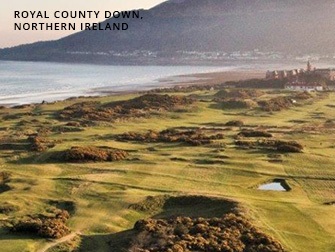The Montgomerie Course at the Carton House Golf Club, located in County Kildare about 15 miles from Ireland’s capital city, Dublin, is once again the host this year’s Irish Open, June 27th-30th. It previously hosted the event when Stephen Dodd won in 2005 and Thomas Bjørn won 2006. The Irish Open proudly enjoys one of the largest galleries on the European Tour. For more details about the Irish Open visit the European Tour’s website.
Tag: portmarnock
Around the Top 100 World – Day 41 to Day 50 / Adelaide to Ayrshire
Click here for trip summary & overview
Day 41 Play Royal Adelaide
At 7:40 am a taxi drove me four miles to Seaton and Royal Adelaide (rated 63, designed by Gardiner 1904 and remodeled by Mackenzie). It hardly ever rains in Adelaide, but that day rain was pelting down, the wind was blowing hard, the temperature was 55 degrees, and the skies were dark. I was greeted by a most friendly young lady in the pro shop. She said I was welcome to start play by myself. With the weather so bad I told her I might wait until the skies cleared. She then informed me that this was ladies’ day and a steady stream of players would be starting shortly. I could not believe that anyone would play in this weather, but sure enough the first group appeared right on time. I rushed to put on golf shoes and headed for the first tee with the golf bag on a hand trolley. At the first tee the rain ceased.
Even though the terrain is fairly flat this proved to be a very tiring round. I was constantly taking off and putting on a jacket as the wind and temperature fluctuated. I kept my rain pants on for the entire day. There was a fierce, but short rain squall accompanied by high winds on the fourteenth hole. The first foursome of ladies was on my heels the whole day as I tried to record detailed course notes while playing and changing clothes.
Afterwards I had a nice chat with the young greens superintendent Mark Prosser. He went there from Royal Melbourne three years before and has done an excellent job. The greens putted reasonably fast and very true. The fairway lies were excellent and the bunkers well maintained. Michael was very inquisitive, and we had a long chat. The club is hosting the Australian Open in 1998, and a few minor modifications in the course have been recommended by Peter Thomson. Michael then produced the club’s centenary book (1892-1992) for me to read.
A while later the manager/secretary Bruce Scott (1987) appeared, and I had an informative chat with him about Mackenzie and the course architecture. In 1926 the club heard that the Doctor was in Perth on a boat headed for Melbourne. They persuaded him to stop for a few hours at Adelaide. At the front entrance he announced his fee was 250 pounds payable in advance. In 1926 this was a substantial sum of money and not available out of petty cash. Apparently the money was found, and Mackenzie spent the rest of the day looking over the property. He came back for a longer stay and submitted a plan. The recommended new course outline was framed and is currently displayed on the club’s walls. Amazingly, not all of the Mackenzie recommendations were implemented because there was great debate within the club over the next several years. Today Royal Adelaide is a mixture of the original 1923 Seaton course, Mackenzie, and to a lesser extent Thomson and Wolveridge.
A taxi took me back to the motel, where I was pleased to find a washer and dryer for guest use. Not knowing when laundry service would next be available, I could not pass up that opportunity. A mediocre evening meal was served in the motel’s dining room.
Day 42 Fly Adelaide/Perth/Johannesburg/Durban
At 7:30 am, with rain coming down, the motel van took me to the airport, where I boarded a Qantas 737-300 for a 3-hour-and-10-minute 1,317-mile flight to Perth. There I set my watch back 1 ½ hours. At 11:30 am a Qantas 747-400 was airborne to Johannesburg on a 10-hour-and 15-minute 5,173-mile flight over the Indian Ocean. My watch was set back another six hours. Although the whole plane was only about 60 percent full, every seat in my upper-deck business class section was taken. This flight goes every other day and, luckily for me, went the day that best fit my schedule.
We arrived in Johannesburg on time, and I was able to obtain a flight earlier than planned to Durban (South African Air 311 miles one hour). At the airport I was met by John-Terry Lloyd (1988) and Greg Larson (1993). After a quick freshening up at the Edward Hotel it was off to dinner at the Durban Country Club with John (former club captain), Greg (former club captain), David Suddards (club captain), John Swain (club president), Barry King (former club captain), and Alf Sudheim (club manager). Everyone but Alf was accompanied by his wife. It was a relaxing time for me, and I was back in the hotel by 10:30 pm and a good night’s sleep. (On this leg of the trip I had flown 6,801 miles and been awake almost 24 hours.)
Day 43 Play Durban Country Club Fly Durban/London
At 8:45 am I was on the first tee of this very busy course with John-Terry Lloyd and David Suddards (played in several British Amateurs and reached the finals once). My caddie, Michael, was shoeless for comfort. The Indian Ocean was visible. The weather was 75 degrees and partly cloudy with no wind. Durban Country Club (rated 72, designed by Waters and Waterman 1922 and remodeled by Hotchkin)(played November 1988) has the distinction of being the only World 100 course with monkeys frolicking around it.
After lunch John took me across the street to the 50,000-seat King’s Park stadium for my first live view of a professional rugby match. The local team, Natal Sharks, was playing the Western Province Lions. Natal won, and with very detailed instructions from John I grasped some, but certainly not all, of the nuances of rugby. Then John took me to the airport for my 10 ½-hour 5,931-mile flight on a British Airways 747-400 to London.
The schedule had allowed for an extra day in Durban in case I did not arrive on time or bad weather caused play cancellation. I had alerted John to Plan B, which was to leave the same day we were first scheduled to play. As you have seen, everything went so smoothly that Plan B was activated. Actually Plan B had a better flight schedule, with the London-bound plane originating in Durban so that there was no change of planes in Johannesburg. Alf made all the arrangements and then faxed PerryGolf in Scotland and Atlanta to inform them of the revised schedule.
Day 44 Arrive London Fly London/Glasgow , Scotland Drive Airport/Troon
Play Royal Troon (Old) Drive Troon/Stranraer
After arrival in London at 8 am (watch set back 2 hours and now using Britain pounds sterling), there was an easy transfer for the one-hour 345-mile flight to Glasgow. A Toyota four-door Carina with manual shift was obtained at Eurodollar Rent A Car. There had been some body damage to the rear door and rear panel, and these were noted on a form. (If you do not check your rental car extra carefully at the beginning you could have big trouble when it is returned.) After all the paperwork was completed I sped 48 miles south to the village of Troon adjacent to the Irish Sea.
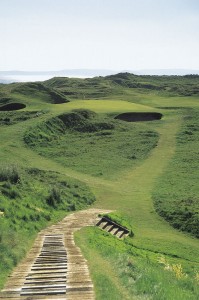
It was not until February that a problem with Royal Troon had become apparent. I had relied on a member to advise me of the situation, and unfortunately he made no effort to ascertain the true circumstances. However, in the end I have no one to blame but myself. Knowing that the club was going to hold an international event, I should have checked directly to see about unusual guest-play restrictions. Royal Troon was hosting The Open in July 1997, and because of guest-play problems before the last Open there, severe restrictions were put in place for the 1997 Open. After many faxes, it turned out that the only day that fit their schedule and mine was my first day in the UK.
Now I was at Royal Troon (Old Course rated 36, designed by Hunter 1878 and remodeled by Fernie, Braid, Mackenzie, and Morrison)(played September 1986) a day early. In the club reception area I found three efficient and understanding staff members as well as the club secretary John Montgomerie (father of Colin). I was directed to the luncheon area and then was able to tee off at 2:30 pm pulling a trolley and playing with an American and an Australian.
The weather was partly sunny, the temperature was about 60 degrees, and a strong 15-mph crosswind was blowing on that early June day. This was my first true links course of the trip, and there was some necessary mental adjustment to the absolutely flat and featureless terrain before me. In the middle of the round the weather turned ugly, with heavy rain and stronger winds than at the start. Note taking had to stop, and all rain gear was put into force. The famous par-3 Postage Stamp 120-yard eighth hole played directly into a 20-mph wind and rain. A six iron was used. Later I was told this was the first meaningful rain at Troon for the past two months.
We played in exactly three hours and afterwards had a refreshment in the comfortable club bar. There I learned that my Australian companion Bruce Johnson was president of the Lakes Golf Club in Sydney and knew David Burton at New South Wales and Bill Richardson at Royal Melbourne, two people I had been with in Australia just a few days before. Golf is indeed a small world.
I then drove 56 miles south to the small town of Stranraer and the North West Castle Hotel. I was a day ahead of the original schedule, but Cameron Reid in the Helensburgh office of PerryGolf rescheduled the room reservations for the next four nights. It was now 9 pm, and the option was dinner or bed. I chose the bed because I had been awake for 36 hours.
Day 45 Ferry Stranraer/Belfast, Northern Ireland Drive Belfast/Ballybunion, Ireland
The original plan had a flight Durban/London/Shannon and this part of the trip starting with play at Ballybunion. The aforementioned situation with Royal Troon caused the schedule to be altered. Early on I decided that even if one course had to be changed I would do anything possible not to change any other part of the schedule. Hence the long trip from Scotland through Northern Ireland and the entire width of Ireland to Ballybunion.
At 9 am I drove on to a SeaCat ferry for the 90-minute ride across the Irish Sea to Belfast. Heavy fog slowed the trip somewhat. Then it took six hours to drive 287 miles between Belfast and Ballybunion. The road system is notoriously poor in the Republic of Ireland, and you cannot plan on going any faster than 40 mph. I arrived at the Marine Links Hotel in early-evening gloom and fog. The windows in my small room were rattling from the strong wind, and rain was pelting down. An above-average meal was had in the hotel dining room. The service was excellent, as it was from all the staff during my entire stay.
Day 46 Play Ballybunion (Old)
The official schedule called for playing Ballybunion (Old Course rated 12, designed by Murphy 1906 and remodeled by Simpson)(first played May 1984 and last played May 1992/total 4 rounds) at 6:50 am the next morning, driving to Lahinch, and playing there at 3 pm. Despite very heavy rain, high wind, and cool temperatures I decided to play Ballybunion as soon as possible. There was no telling how the weather would be the next day and I certainly did not want to play a doubleheader in those weather conditions.
Thus I was at the Ballybunion clubhouse at 7 am and found the first tee crowded with four American foursomes. After an informative chat with the head professional Brian O’Callaghan I was sent out with a father-and-son twosome from Sweden. At 7:30 am I was in full rain gear with my golf bag on my shoulder. The weather was atrocious — cold, heavy rain, strong wind. Even worse, the round took forever because the American group in front of us thought they were playing in a major championship — continual club-selection consultation with caddies, four practice swings on every shot, and then the search for balls after the many inevitable wayward shots.
The locals said there had been no rain there for the past six weeks and it had turned bad only the day before. But how could I complain about the weather because this really was only the fourth bad day of the trip and I was still able to get the job done. After the round I had a long talk with the secretary/manager Jim McKenna.
Returning to the hotel, I asked for a barber shop. An appointment was made, and I walked a few blocks and was greeted by a pleasant young lady. The cut was so short that the hair at the back of my head could not be combed, and gave me the appearance of a rooster. The benefit was that I no longer had to worry about hair in my eyes while playing golf, and I definitely would not need another haircut during the rest of the trip. (Actually the next cut came eight days after the end of the trip.)
Dan Turner arrived, and I took him to the course so that he could enjoy a round in the miserable conditions. We then had a good meal at the hotel.
Day 47 Drive Ballybunion/Lahinch Play Lahinch (Old) Drive Lahinch/Dublin
At 6:30 am we drove to the Tarbert/Shannon Ferry, which is the best way to cross the Shannon Estuary and avoid driving through Limerick on the way to the village of Lahinch. After the 46- mile trip we were at the Lahinch Golf Club (Old Course rated 73, designed by Morris 1893 and remodeled by Mackenzie)(played May 1992) at 9 am. We were scheduled to play at 3 pm, but starter Paul Smith maneuvered us around a group of Korean players, and we even had the course to ourselves as a twosome with our golf bags on our shoulders. The weather was 55 degrees and overcast with a light breeze.
After golf we visited with the secretary/manager Allan Reardon (1992), who told us an interesting story about how most of the Mackenzie-designed greens had been leveled by a member in the mid-1950s. This explains why the Lahinch greens lack the character of typical Mackenzie greens. The club does not have the money or the time to restore the greens because the course receives very heavy play.
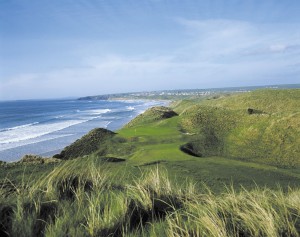
In the early afternoon Dan was formally introduced to the “main road” between Limerick and Dublin as we drove 172 miles to the Deer Park Hotel in Hawth just north of Dublin. An average meal was served in the hotel dining room.
Day 48 Play Portmarnock Drive Portmarnock/Newcastle, Northern Ireland
At 10 am we arrived at the Portmarnock Golf Club (rated 38, designed by Ross 1894 and remodeled by Pickeman and Hawtree)(first played May 1984 and again May 1992/total 2 rounds). My long- time contact there was James McCarthy, but he was ill that day. We went in to see the secretary/manager John Quigley to thank him for arranging our play. (Portmarnock has limited tee times for visitors.) We were then introduced to playing partners Morris Buckley and Ivor Bailey. Morris is the honorary secretary at Portmarnock, which turns out to be a very important position at all golf clubs in Ireland. It is multi-year in duration and provides decision- making stability for the club as various members pass through the club offices.
By 11 am we had our clubs on trolleys and played in 55 degrees with light wind and overcast skies. Even though other players were on the course we played the entire round without being bothered. Following refreshments Ivor led us out on the back roads to the “main road” north. The route took us 94 miles over the border to Northern Ireland, through Newry, and on to the village of Annalong.
Our destination was the Glassdrumman Lodge, which turned out to be a high-end 10-room bed and breakfast. There was a very expensive fixed-price dinner. I ordered lamb chops and was served two overdone and tough tiny chops the size of dimes. The rest of the plate overflowed with vegetables that only a true vegetarian could love. The service started out efficiently and personably, but when a large group of nonresidents arrived we were almost forgotten. My room was directly over the front door, and the noisy group of nonresidents made their exit known when they departed at midnight. As I paid the $190-per-person bill the next morning, I noticed a large sign with bold letters announcing “gratuities are accepted.” That is how you know you are staying at a pseudo-sophisticated establishment that caters to rich American tourists.
Day 49 Play Royal County Down Drive Newcastle/Portrush
At 8 am we were on the road for the 20-mile drive to Newcastle and the Royal County Down Golf Club (rated 10, designed by Morris 1891 and remodeled by Dunn and then Vardon)(played two rounds May 1984). My initial contact was member Charles Adams, who winters in Naples, Florida, and referred to my trip as an orgy. Unfortunately he was not available, and Harry McCaw (1996 R&A Captain) was brought in as a substitute. Harry was the ultimate Irish host, and we had a great day on the course and in the clubhouse.
On this mid-June day we teed off in cloudy 60-degree weather with a light breeze. We had the course to ourselves and enjoyed playing through some towering dunes and soaking in the ambience of the Irish Sea and especially the Mourne Mountains.
Saturday is an institution at County Down, with many of the Belfast members coming down for refreshments, a noon meal, and eventually golf. We circulated in the bar and particularly enjoyed meeting the past captain John Edwards and the current secretary Peter Rolph. After a late lunch Harry invited us to his house, which is just past the eighteenth hole. There we enjoyed viewing some of his memorabilia from his year as R&A Captain. It was a perfect way to end our short stay at County Down.
We then drove 102 miles north past Belfast and on to the town of Portrush. The road system in Northern Ireland is clearly superior to the “road system” in the Republic. It is said that this is the case because the British feel they can more easily catch IRA members if the roads are good. We reached the Royal Court Hotel, which overlooks the Royal Portrush courses and the Irish Sea. Dan went off to play an early evening round of golf, and I went to sleep without having had dinner.
Day 50 Play Royal Portrush (Dunluce) Drive Portrush/Belfast Ferry Belfast/Stranrarer
Drive Stranraer/Turnberry Play Turnberry (Alisa)
Fortunately the hotel had the cold part of the breakfast set up before the prescribed time, and we had a most friendly elderly waitress. We were at the course for our 8 am starting time, which had been arranged by the club secretary Wilma Erskine. During the planning stage Brian Gallagher of the Malone Golf Club was helpful in first establishing contact.
We had our bags on trolleys in a nippy 50 degrees, partly sunny with a 10-mph wind. No one was ahead of us on the Dunluce Course (rated 15, designed by Colt 1920)(played May 1984). After play we said hello to Mrs. Erskine and then enjoyed a substantial Sunday noon meal in the club’s dining room. Then we drove 67 miles to the ferry terminal near downtown Belfast. The 30-mile ferry trip took 75 minutes to Straraner, where we arrived at 6 pm.
Not many golfers know about the landscape just south of Turnberry. In an absolutely perfect early-evening setting with bright sun framing the Irish Sea on one side and the hilly countryside on the other, we breezed up the coastline for one hour to Turnberry. This 37-mile drive is almost as exciting as the drive south of Carmel along the Pacific Coast Highway.
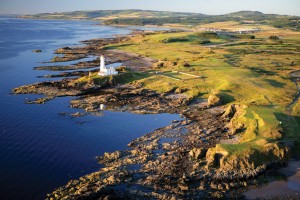
During the drive I mentioned to Dan that maybe we should attempt to play our round at Turnberry that evening instead of early the next morning. Because the next day’s schedule was going to be hectic, completing the round that evening made sense. But the real benefit would be to experience the course (Alisa Course rated 16, designed by Ross 1947)(first played May 1984 and again July 1995/total 6 rounds) bathed in the evening sun and shadows.
Upon arriving we went straight to the pro shop, where we were told by the friendly staff that the course was ours. So the clubs immediately came out of the car trunk (boot in the U. K.) and onto our shoulders. What a memorable evening! The bright sun slowly gave way to beautiful evening shadows and rich colors that highlighted the hotel on the hillside, Alisa Craig, the lighthouse, the war memorial, and the distant islands. The air was cool (60 degrees), the wind was blowing 15 mph, waves were crashing in the Irish Sea, and a full moon was visible. As if on cue the bagpiper started to play by the hotel, and the sounds covered the entire course.
Finishing at 10:30 pm in total darkness we then went to register and were told that the U.S. Open was still on the telly. So we spent the next one and a half hours with room-service food and beverage watching Els finish off Montgomerie and Lehman. At midnight we could reflect on a full day: playing 18 holes in Northern Ireland and another 18 in Scotland and then seeing the final holes of our Open. This was the co-highlight of the trip (along with the Pebble/Cypress day) because we had played the fifteenth- and sixteenth-best courses in the world in one day. There is no way this day could have been planned, and the spontaneity of its last part made it even more special.
TO BE CONTINUED
About the Author: Gordon Dalgleish is the Co-Founding Director of PerryGolf, the leading provider of international golf vacations. You can find him on Google+
Padraig Harrington
I came across the following story about one of Europe’s leading players earlier today. Nowadays it is rare for players to pick up their clubs without being paid a large fee or playing for a large purse, but this is a refreshing example of a top player giving back to an organization who helped him during his career. Padraig Harringon comes across as a genuine, down to earth guy and it comes as no surprise that he is the player involved in this article.
Unfortunately he didn’t win the event held over the Links at Portmarnock, but a solid round of 70 left him only 1 shot behind the winner. Hopefully Padraig’s intense winter training program pays off and he goes on to have a successful season in 2011.
By Gary Sheppard. Gary has been with PerryGolf for over 4 years and is one of our Golf Travel Specialists.
Irish Golf Course Ratings…by the Irish
I read with interest the recently published Irish course ratings in ‘Backspin’, an Irish golf magazine. The ratings were awarded by Irish pros, amateurs and the media…and the resulting list makes for some fascinating reading. The biggest surprise to me was Ballybunion being rated 7th in the Links Courses category – I have played there in the past and thought the course was fantastic. I was also interested to see how well the courses in the Dublin area and Northern Ireland fared, especially the links courses which our clients usually prefer to play. Click here to see details of the full list.
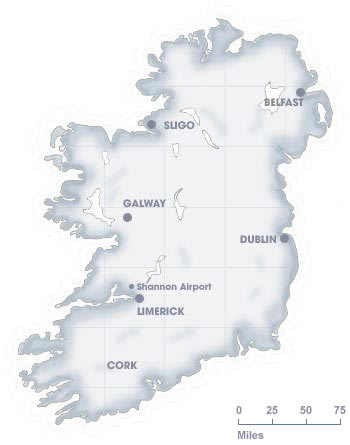
Making use of this list, you could have a fantastic trip based in Dublin then head up to Newcastle and finish on the north coast of Northern Ireland. In Dublin you could play Portmarnock, The European Club, The Island and Royal Dublin (or the Links at Portmarnock Hotel). You could then head north (it’s just over an hour to Baltray) and play Co Louth before continuing up to Newcastle. Here you would play Royal County Down and then continue to the north coast where you might be based at Bushmills and would be perfectly positioned to play Royal Portrush, Portstewart and Ballyliffin. This would make for a great trip and would allow you to play 9 of the top 18 courses mentioned, including all of the top 5! And that is only including the links courses; if you want to mix in a couple of parkland courses, there is also the K Club and Druid’s Glen, both just outside Dublin. What are you waiting for?!
By Alastair Niven. Alastair has been with PerryGolf for over 9 years and is one of our Golf Travel Specialists.
